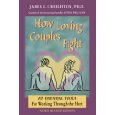How Loving Couples Fight
 How Loving Couples Fight
How Loving Couples Fight
by James L. Creighton, Aslan Publishing; Revised edition (March 15, 1998), 308 pages
Reviewed by Bill McConahey, Lancaster, VA
Bill and Linda are a Certified Leader Couple, Trainers and serve on the Better Marriages National Board of Directors
Late last year, Linda and I had the privilege of sharing with a group of couples on a topic near and dear to our hearts— conflict resolution, or more positively, creative use of conflict. While preparing for that presentation, we came across a book, unfamiliar to us and I suspect to a lot of couples, which was very useful. That book is How Loving Couples Fight by James L. Creighton, Ph.D. David Mace’s aversion to and avoidance of the word “fight” notwithstanding, this book has much to offer any couple working on that aspect of their relationship.
The Maces taught much regarding the inevitability of anger and its common causes as well as endorsing several communication tools and an outline for the activity they referred to as “processing” the anger. This book takes similar material and gives a much more detailed exploration about what causes conflict in the first place and presents a very specific plan for “processing” this very common and aggravating emotion. The first section of the book is “The Ground Rules of Loving Conflict,” and the chapters are “Take Responsibility for the Outcome of Conflicts,” “Accept Conflict as a Normal Part of Human Relationships,” and “Understand the Reality and Importance of Feelings.” A key message in this section is “ it is not the subject of the conflict itself but the ways we respond that will determine whether it is beneficial or destructive,” and “There is not something inherent in conflict that makes it painful; it is what is done with the conflict.”
In the second brief section the author discusses communication tools – an area familiar to most of us. So while this limited review is not new material, it is an appropriate refresher. However, he then moves on to a large section titled “Constructive Fight Tools,” which is quite useful and largely beyond the scope of anything the Maces taught. The chapters are: “Recognize and Break the Spiral of Escalation,” “Identify and Set Limits on Crazy-Making Behavior,” “Replace Power Games with Fight Rules,” and “Use Constructive Ways of Making Up.” In a novel conclusion to this section he describes how a couple can evaluate a fight recently concluded as a growth process for the relationship, but cautions that care must be taken how this is done and suggests that outside help might be useful. In Better Marriages we could use our Marriage Enrichment Groups (MEGs) for this or perhaps a mentor couple if we are fortunate enough to have one.
The final section of the book discusses some problem solving tools such as identifying the real issue and selecting an appropriate strategy to solve it and a process to subsequently evaluate how that strategy worked. The author makes the points that a conflict is an opportunity to grow the relationship and emphasizes, as the Maces did, that if either member of the couple “wins” a fight, the coupleship suffers, and therefore stresses “win-win” solutions—“the whole idea of winners and losers, when applied to intimate relationships, becomes destructive.” He adds that the emotions must be dealt with first, before problem solving techniques can effectively be used.
I found this book to be very helpful and can unreservedly recommend it to others. We are now using it as a book study topic in our weekly MEG. (This book is available at amazon.com.)

